Looking for ready-to-use performance review templates that actually make your job easier? You’re in the right place.
In this blog, I’ll walk you through different types of performance reviews, each with clear descriptions, benefits, and fully structured templates you can copy and use immediately.
No guesswork, just plug-and-play simplicity.
But before that, here is a quick video on tips to nail your next employee performance review:
1. Continuous/Frequent Check-Ins (Weekly/Biweekly)
Continuous or frequent check-ins are informal conversations between managers and employees, typically held weekly or biweekly. They provide a consistent space to align on short-term goals, unblock progress, address emerging challenges, and check in on morale.
These check-ins aren’t about documentation but staying connected, agile, and clear. When done right, they build trust, drive clarity, and prevent small issues from growing into big ones.
How Continuous Check-Ins Are Helpful
- Keeps Execution Sharp: Frequent conversations ensure tasks stay aligned with fast-changing business needs and eliminate drift in focus.
- Surfaces Roadblocks Early: By addressing obstacles quickly, check-ins help avoid escalations and delays before they disrupt progress.
- Strengthens Trust and Transparency: Regular dialogue builds a strong, supportive relationship between employee and manager, creating a culture of psychological safety.
- Supports Real-Time Adaptability: These sessions enable quick adjustments to priorities, making teams more agile in the face of shifting demands.
- Boosts Motivation and Accountability: The rhythm of recurring check-ins helps employees feel seen and supported, while also encouraging consistent follow-through.
Performance Review Templates for Continuous/Frequent Check-Ins
1. Weekly Tactical Execution Review
Hi [Employee Name],
Let’s get into the nuts and bolts of your week:
- Provide a detailed breakdown of the key deliverables you tackled since our last check-in, including anything you completed, made progress on, or had to defer—with a quick note on why.
- Share the top 3 items currently on your plate and explain how they connect to team or business-level goals, including why they’re critical at this moment.
- Call out any blockers—whether they’re related to tools, access, approvals, conflicting priorities, or unclear expectations—and how they’ve affected your momentum.
- Reflect on how long key tasks are taking compared to what you expected, and suggest any adjustments we might need to make to deadlines or resources.
- Highlight any patterns you’re noticing—like recurring inefficiencies, slow response times, or meetings that interrupt flow—and share any improvement ideas you have.
Thanks for always showing up prepared and honest. Your visibility makes a huge difference to our speed and clarity.
2. Well-Being and Emotional Climate Check-In
Hi [Employee Name],
This check-in is focused on how you’re feeling—mentally, emotionally, and holistically—not just what’s on your task list:
- Reflect on your general emotional tone over the past week—have you felt focused, anxious, bored, or enthusiastic? Let’s talk about what’s been driving that mood.
- Share one or two recent moments that lifted your motivation or, conversely, moments that made work feel heavier or draining.
- Give your take on how manageable your current workload is, and whether it feels balanced with the rest of your life, or if it’s starting to spill over.
- Talk about your sense of connection or disconnection with your team, our leadership, and our mission—are you feeling aligned or isolated?
- Recommend one thing—big or small—we could start doing (or stop doing) that would help improve your day-to-day experience or energy levels.
I appreciate your openness here. These conversations matter just as much as any performance metric.
3. Micro Growth and Skills Development Session
Hi [Employee Name],
Let’s take this session to pause and focus on your learning and development:
- Share something new you picked up this week—a tool you used for the first time, a conversation that taught you something, or a mistake that gave you clarity.
- Identify an area where you feel underutilized or ready to level up, and how you envision growing over the next few weeks.
- Talk about any learning opportunities that have recently caught your attention—this could be an internal project, an external course, a mentorship idea, or a topic you’re curious to dive into.
- Describe the challenges or responsibilities you’d like to take on next, especially if they stretch your comfort zone or align with long-term aspirations.
- Let’s align on one small, concrete development goal you can work toward in the next few weeks and how I can support you in achieving it.
Thanks for taking your growth seriously. I’m committed to helping you make steady, meaningful progress.
4. Two-Way Feedback and Relationship Builder
Hi [Employee Name],
Let’s dedicate this check-in to giving and receiving feedback in a way that strengthens our working relationship:
- Reflect on one moment this week that felt like a win for you and explain why you believe it was impactful—this helps us celebrate progress and repeat it.
- Share a situation where you felt things could’ve improved, and walk me through what you’d do differently next time, or what support might’ve helped.
- I’ll offer feedback on one strength I observed this week and one area I think presents an opportunity for continued growth—let’s talk openly.
- Share candid thoughts on how I can better support you—whether it’s more transparent communication, more autonomy, or something else that would elevate your experience.
- Let me know if there are any dynamics in the team or processes you’ve noticed lately that might be helping or hindering collaboration.
Thank you for treating feedback as a dialogue. When we both grow, everything around us improves too.
5. Alignment and Big Picture Calibration
Hi [Employee Name],
Today, I’d like us to zoom out a bit and ensure your current work aligns with what matters most:
- Walk me through your current priorities and share which ones you believe are most directly tied to our key objectives, and which might be losing relevance.
- Give me an honest update on your progress toward any OKRs, KPIs, or sprint-level goals—what’s on track, what’s behind, and where we need to pivot.
- Flag any strategic shifts, recent announcements, or organizational changes that you feel are affecting your focus or direction, positively or negatively.
- Share whether any of your current responsibilities feel repetitive, overly tactical, or misaligned with your role’s intent, and suggest what we could change or delegate.
- Let’s preview the next 2–4 weeks and align on whether your workload and responsibilities are still setting you and the team up for meaningful progress.
Thanks for stepping back to reflect—it’s how we keep daily execution tied to meaningful outcomes.
Ready to 3x Your Teams’ Performance?
Use the best performance management software to align goals, track progress, and boost employee engagement.
2. Monthly Performance Reviews
Monthly performance reviews are short, structured evaluations held every 30 days. They allow HR and managers to review recent achievements, address any issues, and recalibrate goals before small gaps widen.

These monthly reviews benefit new employees, high-growth teams, and short project cycles. They maintain momentum while ensuring performance conversations happen frequently, not just during annual cycles.
How Monthly Performance Reviews Are Helpful
- Provides Early Performance Feedback: Monthly cadence ensures feedback is timely and actionable, rather than delayed for quarters.
- Strengthens Goal Visibility: Employees stay aligned on what matters most, as goals are revisited and recalibrated monthly.
- Identifies Risks Sooner: Performance dips, motivation issues, or role misalignments surface faster and can be addressed proactively.
- Promotes Accountability: Knowing that performance is reviewed monthly increases ownership and discipline around work quality.
- Builds Manager-Employee Rhythm: Regular, documented reviews help establish a healthy, feedback-rich relationship without waiting for formal cycles.
Performance Review Templates for Monthly Check-Ins
1. Monthly Goals and Achievements Snapshot
Employee Name: ______________________
Department/Team: ____________________
Manager Name: _______________________
Review Period: _______________________
A. Goal Status Summary
| Goal | Target Outcome | Status | Notes |
| Goal 1 | (e.g. Complete 2 case studies) | Achieved / In Progress / Blocked | |
| Goal 2 | |||
| Goal 3 |
B. Key Wins This Month
List 2–3 specific accomplishments that had a measurable impact.
C. Areas for Improvement
D. Manager Comments:
E. Employee Reflection (Optional):
2. Role Clarity & Alignment Review
Employee Name: ______________________
Review Date: _________________________
1. What were the top three responsibilities this month?
2. Were there any unclear expectations or conflicting priorities?
☐ No issues
☐ Minor confusion (explain): ____________________________
☐ Major misalignment (describe impact): ___________________
3. Are current tasks aligned with long-term role objectives?
☐ Fully Aligned
☐ Partially Aligned
☐ Misaligned – Adjustment Needed
4. Suggested changes to improve alignment or clarity:
Manager Comments:
3. Monthly Competency Evaluation Grid
| Competency Area | Rating (1–5) | Example/Comment |
| Quality of Work | ||
| Timeliness | ||
| Collaboration | ||
| Communication | ||
| Problem Solving | ||
| Initiative |
Legend:
1 – Needs Significant Improvement
2 – Developing
3 – Meets Expectations
4 – Exceeds Expectations
5 – Outstanding
Manager Overall Assessment:
Employee Signature: ___________ Manager Signature: ___________
4. Monthly Growth & Learning Tracker
Employee Name: __________________
Month Reviewed: ________________
1. New Skills Practiced This Month
- Skill/Tool/Framework: ____________________________
- How it was applied: _____________________________
- Outcome or insight: _____________________________
2. Stretch Assignments or Challenges
3. Training/Coaching Completed
☐ Internal Workshop
☐ Online Course
☐ 1-on-1 Mentorship
☐ None
4. Learning Reflections (What worked? What didn’t?):
Manager Suggestions for Next Month’s Development:
5. Performance Trend Tracker (3-Month View)
| Month | Goal Progress | Quality of Work | Manager Feedback Summary | Score (Optional) |
| Month 1 | ||||
| Month 2 | ||||
| Month 3 |
Employee Engagement Rating (1–5): ___
Flagged Concerns or Positive Trends:
Next Steps / Actions for the Coming Month:
Reviewed By: ____________________ Date: _______________
3. Quarterly Performance Reviews
Quarterly performance reviews are formal evaluations conducted every three months. They strike a balance between agility and structure, giving teams enough time to make meaningful progress while still enabling timely course correction.

These reviews are ideal for aligning with OKRs, evaluating short-term impact, and tracking trends across the year. When run consistently, quarterly reviews foster accountability, engagement, and strategic alignment.
How Quarterly Performance Reviews Are Helpful
- Supports Goal Cadence: Quarterly reviews sync well with OKRs or business cycles, making it easier to evaluate measurable outcomes.
- Encourages Reflection and Reset: They offer employees a natural checkpoint to reflect on wins and challenges before entering the next sprint.
- Prevents Surprises: Regular documentation helps avoid end-of-year review shock and promotes ongoing performance awareness.
- Reveals Patterns Over Time: Reviewing performance every 90 days makes it easier to identify trends, whether they show growth or gaps.
- Builds Manager-Employee Accountability: Scheduled quarterly sessions promote strategic conversation, not just task reviews.
Performance Review Templates for Quarterly Check-Ins
1. Quarterly OKR Performance Review
Employee Name: _________________________
Quarter: Q1 / Q2 / Q3 / Q4
Review Period: From __________ to __________
Manager: _______________________________
A. Objective Review Table
| Objective | Key Results | Achieved? (Y/N) | Notes |
| Objective 1 | KR1, KR2, KR3 | ||
| Objective 2 | KR1, KR2 |
B. Overall Goal Progress Rating:
☐ Outstanding
☐ On Track
☐ Some Progress
☐ Not Met
C. Key Wins This Quarter
D. Areas Needing Improvement
E. Proposed Goals for Next Quarter:
Employee Comments:
Manager Comments:
2. Quarterly Role Contribution Assessment
Employee Name: _________________________
Department: ____________________________
Review Period: _________________________
1. What specific value did the employee add to the team or business this quarter?
2. Were there any new responsibilities or leadership contributions?
☐ Yes (Explain): ______________________________________
☐ No
3. Was the employee a reliable contributor in their core responsibilities?
☐ Always
☐ Mostly
☐ Inconsistently
4. Feedback from peers or other departments (if any):
5. Manager’s overall performance comment:
Score (Optional): ____ / 10
3. 3-Month Behavioral Competency Review
Employee Name: ______________________
Date: _______________________________
| Competency | Rating (1–5) | Example/Justification |
| Accountability | ||
| Collaboration | ||
| Innovation | ||
| Communication | ||
| Leadership (if applicable) |
Competency Notes:
- Accountability: _______________________________________
- Collaboration: _______________________________________
- Communication: _______________________________________
Manager Signature: ___________ Employee Signature: ___________
4. Quarterly Reflection & Goal Reset
Employee Name: _______________________
Review Quarter: _______________________
Manager: _____________________________
Part 1: Employee Reflection
- What achievement are you most proud of this quarter?
- What challenge tested you most, and how did you respond?
- What feedback (formal or informal) stood out to you and why?
Part 2: Manager Feedback
- Your greatest strength this quarter was…
- One area for development in the next 90 days is…
- I recommend you focus on…
Goals for Next Quarter:
5. Quarterly Growth Momentum Tracker
Employee Name: __________________________
Quarter: _________________________________
| Month | Key Accomplishment | Challenge Overcome | New Skill Learned | Growth Rating (1–5) |
| Month 1 | ||||
| Month 2 | ||||
| Month 3 |
Narrative Summary of Growth Journey:
Manager’s Growth Feedback:
Plans for Continued Development:
Ready to 3x Your Teams’ Performance?
Use the best performance management software to align goals, track progress, and boost employee engagement.
4. Semi-Annual Reviews
Semi-annual reviews occur twice a year and serve as a midpoint and endpoint check for employee performance, development, and alignment. They’re more reflective than monthly reviews and less intensive than annual reviews, ideal for evaluating long-term goal progress, refining priorities, and strengthening the manager-employee relationship.

These reviews are often used to recalibrate roles, prepare for promotions, or guide strategic career growth.
How Semi-Annual Reviews Are Helpful
- Provides a Structured Midpoint Evaluation: Serves as a natural pause to assess goals set earlier in the year and refine direction.
- Reinforces Strategic Goals: Helps employees see the big picture by realigning their work to shifting company or team objectives.
- Facilitates Career Conversations: These reviews open the door to discussions about future roles, growth plans, and development gaps.
- Enables Mid-Year Recognition: An opportunity to recognize achievements before year-end awards or bonuses formally.
- Builds Documentation for Promotions or Raises: Regular, detailed feedback creates a fair, data-backed record of performance trends.
Performance Review Templates for Semi-Annual Reviews
1. Mid-Year Performance Summary
Employee Name: ______________________
Review Period: Jan–June / July–Dec
Manager Name: _______________________
Section A: Key Deliverables
List 3–5 high-impact projects or responsibilities from the past 6 months and their outcomes.
Section B: Goal Achievement Review
| Goal | Outcome | Success Level (Met / Partially Met / Not Met) | Notes |
| Goal 1 | |||
| Goal 2 |
Section C: Strengths Demonstrated
Highlight 2–3 professional strengths the employee consistently displayed.
Section D: Growth Opportunities
Identify areas for improvement or skill-building going forward.
Section E: Employee Comments
Section F: Manager Summary & Suggested Next Steps
2. Role Evolution & Readiness Review
Employee Name: ________________________
Review Cycle: H1 / H2
Role/Title: ____________________________
1. Has the employee’s role changed significantly over the past 6 months?
☐ Yes – Role expanded
☐ Yes – Role narrowed
☐ No – Remains consistent
2. Describe any new responsibilities taken on and how they were handled.
3. Is the employee ready for a new challenge (promotion, shift, project lead)?
☐ Ready now
☐ On track but needs more time
☐ Not yet
4. Recommendations for growth or preparation:
Manager Evaluation Summary:
3. Semi-Annual Impact & Influence Review
Employee Name: _______________________
Department: __________________________
Section A: Cross-Team Collaboration & Communication
Evaluate how effectively the employee has worked across functions or with other teams.
- Collaboration examples: ___________________________________
- Any friction points or missed opportunities? ________________
Section B: Innovation & Initiative
Has the employee introduced improvements, ideas, or taken ownership beyond expectations?
Examples: ________________________________________________
Section C: Cultural Contribution
Comment on the employee’s engagement, attitude, or impact on team morale.
Highlights: _______________________________________________
Section D: Summary Score (1–5)
Overall impact rating for this half-year: ___ / 5
4. 6-Month Competency & Values Assessment
| Core Competency or Company Value | Rating (1–5) | Supporting Example |
| Integrity & Ethics | ||
| Customer Obsession | ||
| Ownership | ||
| Results-Oriented Execution | ||
| Continuous Learning |
Legend:
1 – Needs Improvement | 2 – Below Expectations | 3 – Meets Expectations
4 – Exceeds Expectations | 5 – Exceptional
Employee Reflection (Optional):
Manager Summary Comments:
Next Steps (Training / Mentorship / Role Shift):
5. Career Progression & Planning Review
Employee Name: _________________________
Position: ______________________________
Manager: _______________________________
1. Career Aspirations (Discussed with Employee):
- Short-term (1–2 years): ___________________________
- Long-term (3–5 years): ____________________________
2. Current Role Fit
☐ Perfect Fit
☐ Some Skill Gaps
☐ Too Limited for Growth
3. Suggested Development Pathways:
- Lateral Skill Building: _________________________
- Leadership Exposure: __________________________
- Stretch Assignments: ___________________________
4. Development Milestones for Next 6 Months:
5. Recommended Actions (by Manager):
☐ Recommend for promotion
☐ Assign a mentor or coach
☐ Revisit in next review
5. Annual Performance Reviews
Annual performance reviews are the most comprehensive type of review, conducted once a year to evaluate an employee’s contributions, growth, and alignment with organizational goals over a 12-month period.
These reviews often influence promotions, bonuses, raises, and strategic career planning. While traditionally formal, modern annual performance reviews are shifting toward being collaborative, forward-looking, and development-driven.
How Annual Performance Reviews Are Helpful
- Captures the Full-Year Perspective: Offers a holistic view of accomplishments, patterns, and impact over time, not just short-term performance.
- Aligns Performance with Rewards: Provides the basis for decisions around compensation, promotions, and recognition.
- Highlights Strategic Development Needs: Identifies long-term growth opportunities and skill gaps to focus on in the year ahead.
- Encourages Career Planning: Opens structured conversations around progression, aspirations, and potential pathways within the company.
- Fulfills Compliance and Recordkeeping: Serves as official documentation of performance evaluations, useful for audits and HR processes.
Performance Review Templates for Annual Reviews
1. Annual Performance Summary & Evaluation
Employee Name: __________________________
Position: ________________________________
Review Period: January 1 – December 31, 20XX
Department: _____________________________
Manager: ________________________________
A. Annual Objectives & Goal Review
| Objective | Target Outcome | Result Achieved | Notes |
| Obj 1 | Yes / Partial / No | ||
| Obj 2 |
B. Key Achievements
C. Challenges & Barriers
D. Overall Rating (Select One):
☐ Exceptional
☐ Exceeds Expectations
☐ Meets Expectations
☐ Needs Improvement
☐ Unsatisfactory
E. Manager Comments:
F. Employee Comments (Optional):
G. Final Recommendation:
☐ Promotion Consideration
☐ Raise Recommended
☐ Development Plan Required
☐ No Action
2. Year-End Competency & Skills Grid
Employee Name: ________________________
Review Period: _________________________
| Competency Area | Rating (1–5) | Examples/Behavioral Evidence |
| Technical Skills | ||
| Communication | ||
| Collaboration | ||
| Initiative | ||
| Decision-Making |
Legend:
1 – Needs Improvement
2 – Developing
3 – Proficient
4 – Highly Effective
5 – Role Model
Additional Notes from Manager:
Overall Competency Score: ___ / 25
3. Strategic Impact & Business Value Report
Employee Name: _________________________
Role: _________________________________
Manager: ______________________________
1. How did the employee contribute to key company initiatives this year?
2. What measurable results or outcomes can be attributed to their work?
3. Describe how this employee added value beyond their role (e.g., mentoring, thought leadership, process improvement).
4. Any concerns that could impact long-term business value?
Final Assessment of Business Impact:
☐ Low
☐ Moderate
☐ High
☐ Exceptional
4. Behavior & Cultural Alignment Review
Employee Name: _________________________
Review Period: _________________________
| Company Value or Behavior | Aligned (✔) | Examples | Notes |
| Customer First | |||
| Ownership Mindset | |||
| Bias for Action | |||
| Teamwork & Respect | |||
| Innovation |
Employee Self-Reflection on Cultural Fit:
Manager’s View on Cultural Alignment:
Suggested Actions:
☐ Continue current approach
☐ Coaching required
☐ Eligible for leadership path
5. Annual Career Development Plan
Employee Name: _________________________
Manager: _______________________________
Date: _________________________________
1. Career Aspirations Discussed:
- Short-Term (next 12 months): _______________________
- Long-Term (next 2–3 years): ________________________
2. Skills to Develop in the Next Year:
3. Projects or Roles to Support Growth:
4. Development Resources Needed:
☐ Formal Training
☐ Mentorship
☐ Cross-Functional Exposure
☐ Stretch Assignments
5. Next Review Milestone:
☐ Mid-Year
☐ Quarterly
☐ Monthly Check-In
Ready to 3x Your Teams’ Performance?
Use the best performance management software to align goals, track progress, and boost employee engagement.
6. New Hire 30-60-90 Day Reviews
What happens when you hire someone? Well, the journey can be highlighted briefly as in the image below:
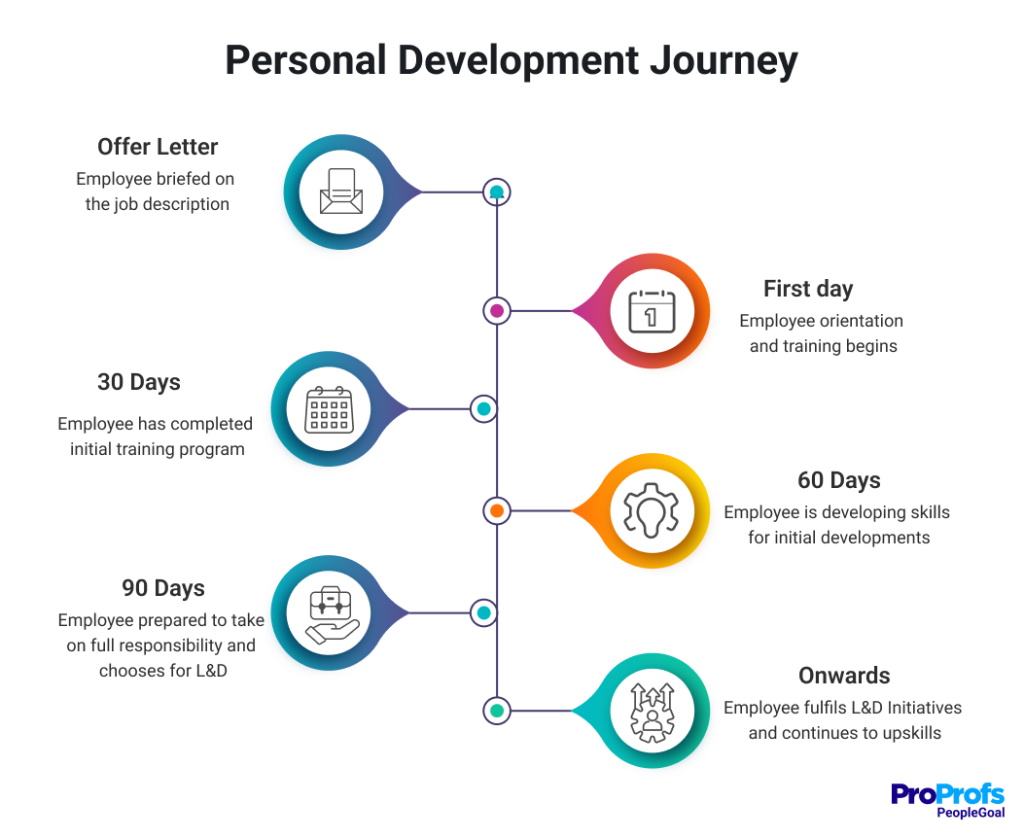
30-60-90 day reviews are structured milestone evaluations that track a new hire’s progress through their onboarding period. Each stage, whether 30, 60, or 90 days, marks a checkpoint to assess role understanding, cultural fit, training outcomes, and performance indicators.
These reviews help ensure early alignment, surface support needs, and prevent missteps during a critical transition period.
How 30-60-90 Day Reviews Are Helpful
- Sets Clear Expectations Early: Each phase outlines goals and learning outcomes, preventing ambiguity in a new hire’s role.
- Monitors Integration & Fit: Helps assess how well the employee is adapting to the team, tools, and company culture.
- Identifies Gaps Quickly: Surfaces skill gaps or onboarding friction before they become larger performance issues.
- Provides Psychological Safety: Structured touchpoints show support and give the employee a safe space to ask questions and raise concerns.
- Supports Retention & Success: New employees with guided onboarding and early feedback are more likely to thrive and stay long-term.
Performance Review Templates for 30-60-90 Day Reviews
1. 30-Day Review: Onboarding & Understanding
Employee Name: _________________________
Start Date: _____________________________
Manager: _______________________________
Review Date: ____________________________
Section A: General Orientation
- Completed all required onboarding sessions: ☐ Yes ☐ No
- Has a clear understanding of company mission, policies, and values: ☐ Yes ☐ Somewhat ☐ No
- Feels adequately welcomed and supported by the team: ☐ Yes ☐ No
Section B: Role Familiarity
- Understands core job responsibilities: ☐ Fully ☐ Mostly ☐ Needs More Clarity
- Can navigate tools and systems required for the role: ☐ Independently ☐ With Help ☐ Not Yet
Section C: Immediate Observations
- Positive signs (e.g., proactiveness, curiosity):
- Challenges or concerns noticed:
Section D: Focus for Next 30 Days
2. 60-Day Review: Performance & Adjustment
Employee Name: _________________________
Department: ____________________________
Review Date: ____________________________
1. Skill Application
| Task or Responsibility | Level of Independence | Comments |
| Task 1 | ☐ Full ☐ Partial ☐ Not Yet | |
| Task 2 |
2. Quality of Work
- Delivers work on time and with expected quality:
☐ Always
☐ Mostly
☐ Occasionally
- Shows attention to detail and initiative:
☐ Strongly
☐ Moderately
☐ Needs Improvement
3. Integration into Team
- Communication with peers and manager:
- Participation in meetings and discussions:
4. Developmental Feedback
- What they’re doing well: ____________________________
- What to work on before day 90: _______________________
Next Phase Focus:
3. 90-Day Review: Readiness & Retention
Employee Name: _________________________
Manager: _______________________________
Review Period: First 90 Days
A. Overall Assessment
| Category | Rating | Notes |
| Job Knowledge | ☐ Exceeds ☐ Meets ☐ Below | |
| Accountability | ☐ Exceeds ☐ Meets ☐ Below | |
| Adaptability | ☐ Exceeds ☐ Meets ☐ Below | |
| Collaboration | ☐ Exceeds ☐ Meets ☐ Below |
B. Culture & Engagement
- Feels aligned with team and values: ☐ Yes ☐ Partially ☐ No
- Demonstrates company values in daily behavior:
C. Role Fit & Commitment
- Employee shows long-term fit for the role: ☐ Strongly Agree ☐ Agree ☐ Not Sure
- Employee intends to stay: ☐ Confirmed ☐ Undecided ☐ Concern Raised
D. Final Recommendation:
☐ Fully onboarded, continue as-is
☐ Extend onboarding period
☐ Escalate for further discussion
4. Manager Checklist – 30-60-90 Support Plan
Manager Name: __________________________
Employee: ______________________________
| Phase | Action | Completed | Notes |
| 30 Days | Reviewed role clarity and first-week tasks | ☐ | |
| Introduced to key collaborators | ☐ | ||
| Assigned first small project | ☐ | ||
| 60 Days | Reviewed first deliverables and feedback | ☐ | |
| Clarified team processes & workflows | ☐ | ||
| 90 Days | Held feedback conversation on future goals | ☐ | |
| Transitioned to regular review cadence | ☐ |
5. 30-60-90 Day Milestone Tracker (Employee-Facing)
Employee Name: _________________________
Manager: _______________________________
Start Date: ____________________________
| Day | Focus Area | Goal | Status | Employee Notes |
| 30 | Orientation & Tools | Complete onboarding & system access | ☐ Done ☐ Pending | |
| 60 | Role Execution | Deliver 1–2 real projects with quality | ☐ Done ☐ In Progress | |
| 90 | Ownership & Feedback | Demonstrate independence & align with role goals | ☐ Ready ☐ Needs Support |
Reflection (Optional):
- What’s been most helpful so far?
- What support do you still need?
Signature (Employee): ____________ Date: ___________
Signature (Manager): ____________ Date: ___________
7. Probationary Period Reviews
A probationary period review is a formal performance assessment conducted at the end of an employee’s probationary period, usually 60, 90, or 180 days after joining.
Here’s what a simple probation process looks like:
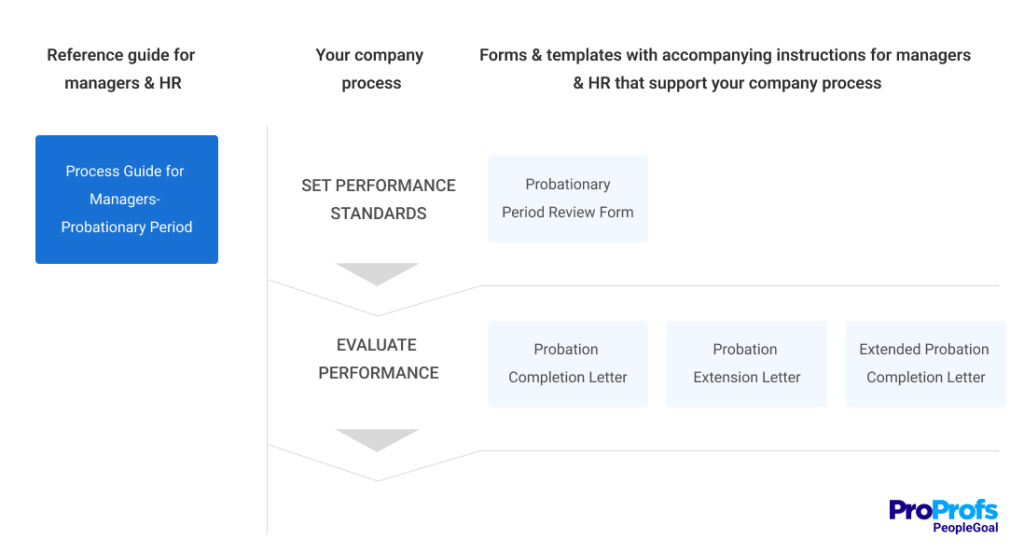
Unlike standard check-ins, this review is a critical decision-making point: it determines whether the employee will continue in the role, needs extended support, or be offboarded. It evaluates performance, learning curve, behavior, and long-term fit.
How Probationary Period Reviews Are Helpful
- Establishes a Clear Evaluation Deadline: Sets a well-defined timeframe for reviewing whether a new hire meets baseline expectations.
- Mitigates Risk Early: Helps identify underperformance or cultural misalignment before permanent employment is confirmed.
- Standardizes the Confirmation Process: Ensures all employees are assessed fairly using consistent performance and behavior metrics.
- Protects Company Investment: Saves time and resources by validating whether to continue investing in the employee.
- Strengthens Onboarding Outcomes: Encourages better coaching and documentation during early employment phases.
Performance Review Templates for Probationary Period Reviews
1. Probation Completion Evaluation Form
Employee Name: _________________________
Start Date: _____________________________
Position: _______________________________
Manager: _______________________________
Review Date: ____________________________
A. Job Knowledge & Execution
| Area | Rating | Notes |
| Understanding of Role | ☐ Exceeds ☐ Meets ☐ Needs Improvement | |
| Ability to Follow Procedures | ☐ Exceeds ☐ Meets ☐ Needs Improvement | |
| Task Completion | ☐ On Time ☐ Late ☐ Incomplete |
B. Behavior & Attitude
- Demonstrates reliability and professionalism: ☐ Yes ☐ No
- Communicates effectively with team and manager: ☐ Yes ☐ Sometimes ☐ No
- Open to feedback and learning: ☐ Yes ☐ Some Resistance ☐ Resistant
C. Overall Cultural Fit:
☐ Strong Fit
☐ Developing Fit
☐ Misaligned with Core Values
D. Final Recommendation:
Confirm Employment
Extend Probation by _____ Days
Terminate Employment
Other: ___________________________________
2. Manager’s Summary Review (Narrative-Based)
Employee Name: _________________________
Review Date: ____________________________
1. How has the employee adapted to the role?
2. Describe the employee’s strengths and contributions so far.
3. Where are you seeing hesitation, skill gaps, or underperformance?
4. How well is the employee adapting to the company culture, pace, and processes?
5. What support was provided, and how did the employee respond to coaching or feedback?
Manager’s Overall Evaluation:
Manager Signature: _____________ Date: _____________
3. 360 Snapshot: Peer & Mentor Input (Optional)
Employee: _______________________________
Collected By: ___________________________
Review Period: __________________________
| Contributor | Role/Relation | Strengths Observed | Suggestions |
| Peer A | Onboarding Buddy | “Proactive and quick learner” | “Needs to ask for help more readily” |
| Peer B | Cross-Team Partner | _________________________ | _____________________ |
| Mentor | Dept. Lead | _________________________ | _____________________ |
Summary Themes (by HR or Manager):
- Strengths: ________________________________________
- Areas to Watch: ____________________________________
4. Probation Period Self-Review
Employee Name: _________________________
Date: _________________________________
1. What do you feel you’ve learned or accomplished during the probation period?
2. What parts of the role have been easiest for you to grasp?
3. Where have you struggled or needed more support?
4. How do you feel about your fit within the team and the company?
5. What support or training would help you move forward confidently?
Employee Signature: _____________ Date: _____________
5. Probation Status Decision Memo (HR Record Format)
Employee Name: ________________________
Probation Start Date: ___________________
Review Date: ___________________________
Position: ______________________________
Manager: ______________________________
Performance Summary (bullet format):
- Met or exceeded all onboarding goals
- Positive feedback from peers and the team
- Showed proactive problem-solving and ownership
- Minor delays in initial task execution improved over time
Concerns or Risks (if any):
HR Note:
After consultation with the hiring manager, we recommend the following:
☐ Confirm employment (full-time)
☐ Extend probation to further assess fit
☐ Terminate per probationary clause
☐ Schedule follow-up review in 30 days
Approved By (HR): ___________________ Date: ___________
Approved By (Manager): ______________ Date: ___________
Ready to 3x Your Teams’ Performance?
Use the best performance management software to align goals, track progress, and boost employee engagement.
8. Project-Based Reviews
Project-based reviews are conducted at the completion of a significant project, sprint, campaign, or client engagement. These reviews focus on assessing an employee’s contributions, teamwork, decision-making, problem-solving, and accountability specific to that project.

They offer a timely, contextual look at real performance and help connect day-to-day execution to organizational results.
How Project-Based Reviews Are Helpful
- Connects Performance to Outcomes: Ties employee behavior and decisions directly to project results and success metrics.
- Enables Timely Recognition: Offers immediate feedback, praise, and course correction while the project is still fresh in mind.
- Improves Future Collaboration: Surfaces interpersonal dynamics, communication challenges, or missed handoffs that can be improved in the next round.
- Reinforces Ownership and Accountability: Employees learn how their role impacts timelines, quality, and team effectiveness.
- Feeds Into Broader Appraisals: Project feedback can be rolled into quarterly or annual reviews for a more holistic picture of performance.
Performance Review Templates for Project-Based Reviews
1. Individual Project Contribution Report
Employee Name: __________________________
Project Title: ____________________________
Project Dates: From __________ to __________
Manager/Lead Reviewer: ___________________
Section A: Role in the Project
Describe the employee’s defined responsibilities in this project:
Section B: Deliverables & Execution Quality
- What were the specific outputs delivered?
- Were deadlines met? ☐ Yes ☐ Partially ☐ No
- Did the quality meet expectations? ☐ Exceeded ☐ Met ☐ Fell Short
Section C: Strengths Demonstrated
Technical expertise, ownership, speed, etc.:
Section D: Development Notes
What could have been done differently or improved upon?
Overall Performance for This Project:
☐ Outstanding
☐ Strong
☐ Satisfactory
☐ Needs Improvement
2. Project Peer Review Snapshot
Employee Being Reviewed: ___________________
Reviewer Name: _____________________________
Project: ___________________
Role in Project: ____________________________
| Area | Rating (1–5) | Comments |
| Team Communication | ||
| Responsiveness | ||
| Collaboration | ||
| Conflict Handling | ||
| Shared Accountability |
Would you want to work with this person again on future projects?
☐ Absolutely ☐ Yes ☐ Maybe ☐ No
Any additional comments or feedback?
3. Project Retrospective: Self-Assessment Template
Employee Name: ___________________________
Project Title: ____________________________
Review Date: _____________________________
1. What was your primary role and scope during this project?
2. What went well from your perspective?
Describe your proudest contributions:
3. What could have gone better?
Mention missed opportunities, errors, or areas where more clarity was needed:
4. How did you collaborate with the team?
Communication, coordination, or support feedback:
5. Lessons learned and what you’d apply next time:
4. Project Performance Scorecard (Objective-Based)
Employee Name: ___________________________
Project Name: ____________________________
| Metric/Category | Description | Rating (1–5) | Evidence/Example |
| Deadline Adherence | Met milestones and delivery targets | ||
| Quality of Work | Accuracy, presentation, detail-orientation | ||
| Problem Solving | Navigated ambiguity, made sound decisions | ||
| Initiative | Took ownership, went beyond the defined scope | ||
| Stakeholder Feedback | Internal/external reactions |
Overall Average Score: _____ / 25
Manager Summary Notes:
5. Project Completion & Feedback Log (Multi-Manager Input)
Employee: ___________________________
Project: ____________________________
Dates: _____________________________
| Reviewer | Function | Key Comment | Suggested Action |
| PM | Delivery | “Exceeded in cross-team alignment” | “Involve earlier in scope planning” |
| QA Lead | Testing | ___________________ | _____________________ |
| Client Rep | External | ___________________ | _____________________ |
Aggregate Feedback Themes:
- Strengths observed: _____________________________________
- Improvement areas: _____________________________________
Final Status:
☐ Project closed, feedback recorded
☐ Requires follow-up coaching
☐ Consider for future lead/project owner role
9. Performance Improvement Plan (PIP) Review
A Performance Improvement Plan (PIP) review is a formal evaluation conducted at the end of a set improvement period, usually 30, 60, or 90 days, after an employee is placed on a PIP.
Here’s what the structure of a PIP looks like:
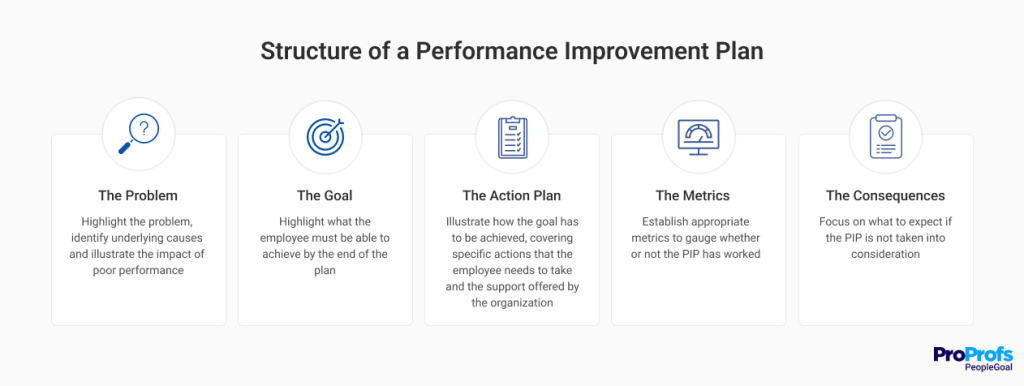
This review determines whether the employee has met the specific, measurable goals outlined in the plan. It’s a critical, often sensitive checkpoint to decide whether to continue employment, extend support, or take further action.
How PIP Reviews Are Helpful
- Creates Structure for At-Risk Employees: Offers a clear path with specific goals and deadlines to help struggling employees improve.
- Encourages Accountability: Puts ownership in the hands of the employee while giving the manager tools to coach effectively.
- Documents Performance Legally and Fairly: Serves as formal, trackable evidence in the case of termination decisions or HR audits.
- Enables Honest Conversations: Makes space for open, documented dialogue about expectations and consequences.
- Supports Fair, Rehabilitative Outcomes: Gives underperformers a realistic chance to recover, clarify misunderstandings, or request additional support.
Performance Review Templates for PIP Reviews
1. PIP Closure Evaluation Report
Employee Name: __________________________
Department: _____________________________
PIP Start Date: __________ End Date: __________
Manager: ________________________________
HR Representative: _______________________
A. Goals From the PIP
| Performance Area | Goal | Status (Met/Not Met) | Notes |
| Quality | Deliver client-ready reports with no errors | Met | Documented improvements in accuracy |
| Timeliness | Submit all weekly tasks on time | Not Met | 2 deadlines missed in Week 2 |
B. Manager Summary of Observations:
C. Summary of Coaching & Support Provided:
- Weekly 1:1s conducted
- Provided a writing assistant tool
- Partnered with a mentor for onboarding
D. Final Recommendation:
Successfully Completed PIP — Return to Normal Performance Track
Partial Progress — Extend PIP by ___ Days
No Improvement — Recommend Termination
Other: _______________________________________________
Manager Signature: __________
HR Signature: __________ Date: __________
2. PIP Weekly Tracker Template
Employee: __________________________
Manager: ___________________________
Week #: _______ Date: __________
| Focus Area | Weekly Goal | Progress Summary | Rating (1–5) | Notes |
| Task Completion | Complete backlog items by Wed | Delivered by Thursday | 3 | Slight delay, improving |
| Communication | Send EOD updates daily | Missed 2 updates | 2 | Needs better routine |
Weekly Check-In Summary (Manager):
This week, [Employee] made progress in [Area X], but still struggled with [Area Y].
Employee Feedback:
Next Week’s Goals:
3. PIP Self-Review Form (End of Period)
Employee Name: ________________________
Review Date: __________________________
1. What do you believe you improved the most during the PIP period?
2. Which goals did you fully meet, and how?
3. Where do you feel you still need support or more time?
4. What feedback did you receive that was most useful?
5. How committed are you to sustaining improvements moving forward?
☐ Fully committed ☐ Somewhat ☐ Unsure
Employee Signature: ___________ Date: ___________
4. PIP Outcome Meeting Template (Discussion Framework)
Meeting Date: __________________________
Participants: Manager, HR, Employee
Opening Summary by Manager:
“Over the last 60 days, we agreed on specific improvement goals related to [X, Y, Z]. I’d like to walk through each and assess where we’ve landed.”
Discussion Points:
- Review each PIP objective and status (achieved, partially achieved, unmet)
- Reflect on what has changed—positively or not
- Ask the employee to self-assess and comment on lessons learned
- Acknowledge efforts made, regardless of the final result
- Clearly state the outcome and next steps: reintegration, extension, or exit
Documented Outcome:
☐ Continued Employment
☐ PIP Extension
☐ Employment Termination
Meeting Notes (HR):
5. Performance Improvement Summary Memo (For HR Records)
Employee: ____________________________
PIP Duration: ______ Days
Supervisor: __________________________
HR Contact: __________________________
Purpose of PIP:
“Address repeated issues with [insert performance or behavior concern], including specific incidents such as…”
Summary of Performance During PIP:
- Improvements Observed: ______________________________________
- Missed Targets or Persistent Concerns: _________________________
Decision Summary:
☐ Reinstated to Active Role
☐ PIP Extended to [Date]
☐ Final Warning Issued
☐ Termination Effective [Date]
Approved By:
- Manager: __________________ Date: __________
- HR Lead: __________________ Date: __________
Ready to 3x Your Teams’ Performance?
Use the best performance management software to align goals, track progress, and boost employee engagement.
10. Ad Hoc/Off-Cycle Reviews
Ad hoc or off-cycle reviews are unscheduled performance evaluations initiated in response to specific events, such as a sudden performance issue, a major achievement, a team conflict, or a request for promotion.
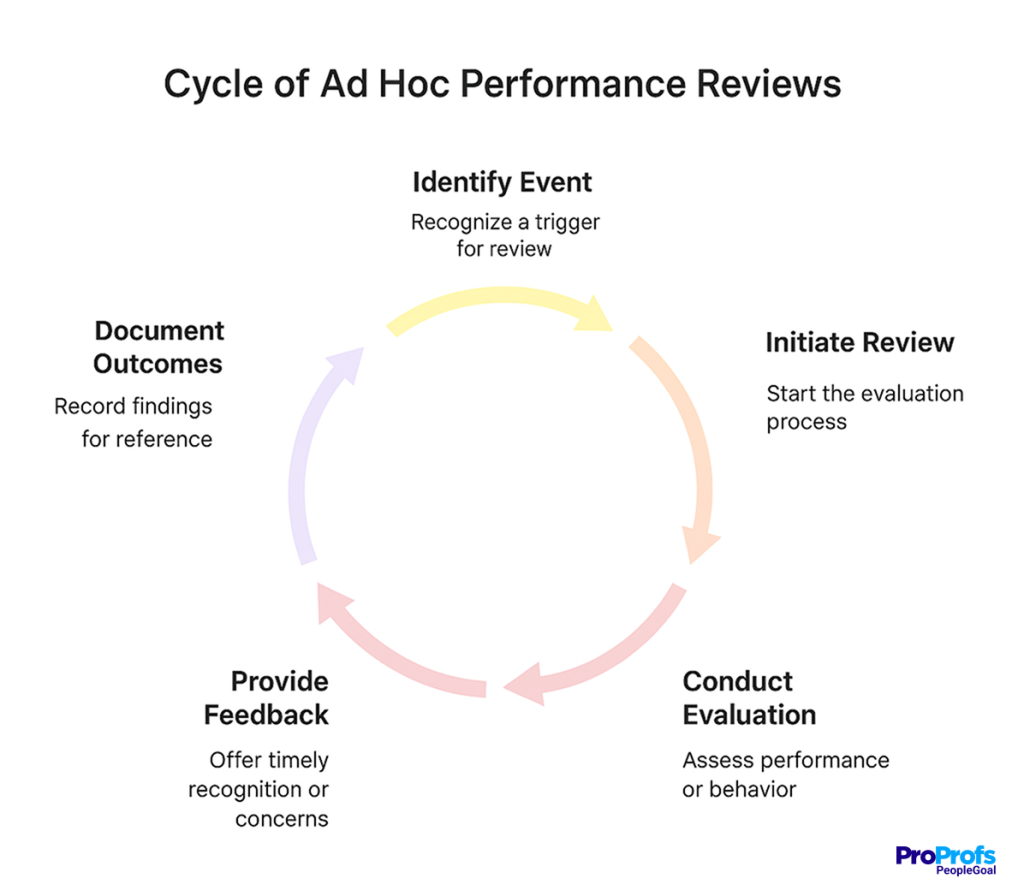
These reviews fall outside the standard cadence and are typically used to address urgent matters, offer timely recognition, or document behavior-related concerns in real-time.
How Ad Hoc Reviews Are Helpful
- Provides Timely Intervention: Allows managers to address performance issues or celebrate wins without waiting for formal review cycles.
- Captures Context Before It Fades: Documents performance or behavior while details are still fresh, increasing accuracy and fairness.
- Supports Agile Recognition or Correction: Reinforces behaviors that should be repeated or corrected as soon as possible.
- Fosters Responsiveness to Employee Needs: Can be triggered by an employee’s own request, especially during role transitions or conflict resolution.
- Improves Documentation: Supplements the formal review record with time-stamped evidence for HR tracking, coaching, or decision-making.
Performance Review Templates for Ad Hoc/Off-Cycle Reviews
1. Ad Hoc Performance Incident Review Form
Employee Name: _________________________
Department: ____________________________
Date of Review: ________________________
Initiated By: ☐ Manager ☐ HR ☐ Employee
A. Trigger for Review:
Sudden drop in performance
Major achievement
Behavioral concern
Team conflict
Employee request
Other: ____________________________
B. Summary of Event or Behavior:
Describe what happened, when, and its impact.
C. Action Taken So Far (if any):
☐ Coaching provided
☐ Verbal warning
☐ Recognition email sent
☐ No prior action
D. Immediate Outcome of Review:
☐ Performance discussion documented
☐ Escalated to HR
☐ Recognition added to personnel file
☐ Next check-in scheduled for: ___________
Manager Comments:
2. Ad Hoc Recognition & Achievement Memo
Employee: __________________________
Manager: ___________________________
Date: _____________________________
Context:
This memo formally recognizes [Employee Name] for an outstanding performance milestone that occurred outside the normal review window.
Description of Achievement:
- What was accomplished: _____________________________________
- Why it mattered: ___________________________________________
- Who it impacted (team, client, business): ______________________
- Any quantifiable results or metrics: ____________________________
Recognition Action:
☐ Bonus recommended
☐ Public acknowledgment (e.g., town hall, email)
☐ Promotion discussion scheduled
☐ Spot award nomination
Optional Quote from Leadership:
3. Off-Cycle Behavior or Conduct Evaluation
Employee Name: __________________________
Supervisor: _____________________________
Date: _________________________________
Incident Description:
Include dates, context, and who else was involved.
Policy or Expectation Involved:
Employee’s Explanation (if already gathered):
Manager or HR Assessment:
- Is the issue isolated or recurring?
- Impact on morale, workflow, or culture?
Action Plan (if applicable):
☐ Coaching Plan
☐ Verbal/Written Warning
☐ Behavioral Expectation Recommitment Form
☐ Schedule Follow-Up in ___ Days
4. Off-Cycle Promotion Readiness Review
Employee: __________________________
Manager: ___________________________
Review Date: _______________________
Role Considered For: __________________
1. Reason for Off-Cycle Promotion Consideration:
☐ Exceeded performance consistently
☐ Stepped into higher responsibilities
☐ Market adjustment/retention
☐ Special project leadership
2. Key Contributions Supporting Promotion:
3. Peer or Cross-Functional Feedback Summary:
4. Capability Gap (if any):
☐ None
☐ Minor — coachable
☐ Significant — recommend waiting
Final Recommendation:
☐ Proceed with promotion
☐ Hold and reassess in ___ days
☐ Reassign to development track
5. Ad Hoc Employee-Initiated Check-In Record
Requested By: ☐ Employee ☐ Manager
Employee Name: ________________________
Date of Review: ________________________
1. Reason for Request:
Requesting feedback
Role clarity or expectation issue
Career path discussion
Conflict resolution
Other: ___________________________
2. Summary of Discussion:
- Key concerns shared by the employee:
- Feedback provided by the manager:
- Next agreed-upon steps:
Follow-Up Needed:
☐ Schedule follow-up meeting
☐ Assign a mentor or a resource
☐ Re-route to HR or leadership
☐ Add notes to the annual review file
Signatures (Optional):
Employee: ____________ Manager: ____________ Date: ____________
11. Continuous Feedback Reviews
Continuous feedback reviews are ongoing, real-time performance conversations that happen frequently, daily, weekly, or as tasks are completed. Unlike formal reviews, continuous feedback are informal and lightweight, but they are often documented to capture patterns over time.
Here are some pros and cons of continuous feedback reviews:

These reviews are especially useful in agile environments and feedback-driven cultures, where timely reinforcement or redirection matters more than formal ratings.
How Continuous Feedback Reviews Are Helpful
- Reinforces Positive Behavior Quickly: Immediate feedback encourages repetition of good practices before momentum fades.
- Corrects Issues in Real Time: Rather than waiting for a review cycle, managers can help course-correct on the spot.
- Builds a Culture of Openness: Normalizes everyday feedback, making it less intimidating and more collaborative.
- Promotes Coaching Over Critiquing: Shifts the focus from judgment to guidance, creating a safe space for growth.
- Provides a Trail of Micro-Evidence: When tracked, these insights become powerful input for quarterly, annual, or promotion reviews.
Performance Review Templates for Continuous Feedback Reviews
1. Micro-Feedback Entry Log
Employee: __________________________
Manager: ___________________________
Date of Feedback: __________________
| Area | Type of Feedback | Observation | Suggested Next Step |
| Presentation | Positive | Clear storytelling, great client engagement | Use the same approach in the next pitch |
| Task Ownership | Constructive | Missed the follow-up email on Thursday | Add a reminder workflow to the task system |
Feedback Given In:
☐ Verbal ☐ Email ☐ Chat ☐ In-Person
Logged by: __________________________
2. Continuous Feedback Record Sheet (Rolling Log)
| Date | Topic | Feedback | Type | Employee Reaction | Logged By |
| 07/02 | QA Testing | Excellent documentation detail | Positive | Appreciated and acknowledged | Manager |
| 07/05 | Standups | Late to the daily sync twice | Constructive | Apologized and adjusted the schedule | Team Lead |
| 07/09 | Team Collaboration | Took initiative to help new hire | Positive | Appreciated the recognition | Manager |
Usage: Add a line every time feedback is shared, no matter how small.
3. Weekly Snapshot Feedback Template
Employee Name: _______________________
Week of: _____________________________
Feedback Provider: ___________________
1. What went well this week?
2. Where could improvement happen?
3. Did the employee take initiative or display ownership?
☐ Yes (describe): ____________________________
☐ Not observed
4. Quick coaching point for next week:
Sign-Off:
☐ Feedback shared with employee verbally or in writing
4. 1:1 Feedback Loop Template
Employee: ____________________________
Manager: _____________________________
Date of 1:1: __________________________
Highlights Since Last Check-In:
- Key wins or improvements observed:
- Notable obstacles or missteps:
Discussion Notes:
- What the employee said they’re proud of:
- Feedback they requested or responded to:
Next Feedback Focus:
- Behavioral or skill area to track this week:
Next Check-In Date: ___________________
5. Pulse Feedback Wall (Team-Based Template)
Employee Being Recognized: ___________________
Feedback Contributor: ________________________
Feedback Date: _____________________________
Feedback Type:
☐ Positive Reinforcement
☐ Constructive Suggestion
☐ Recognition from peers
☐ Client Compliment
Message:
“I saw you __________ when __________, and I really appreciated how you handled it. It showed __________.”
Action Taken (if any):
☐ Shared publicly
☐ Logged in HRIS
☐ Shared privately
☐ Saved for next review cycle
Optional Emoji Rating (Culture Fit):
12. Employee-Initiated Reviews
An employee-initiated review is a performance conversation requested by the employee rather than scheduled by HR or management. It may be prompted by a desire for feedback, a role clarification, readiness for more responsibility, or interest in employee career development.
Here’s what the process may look like:
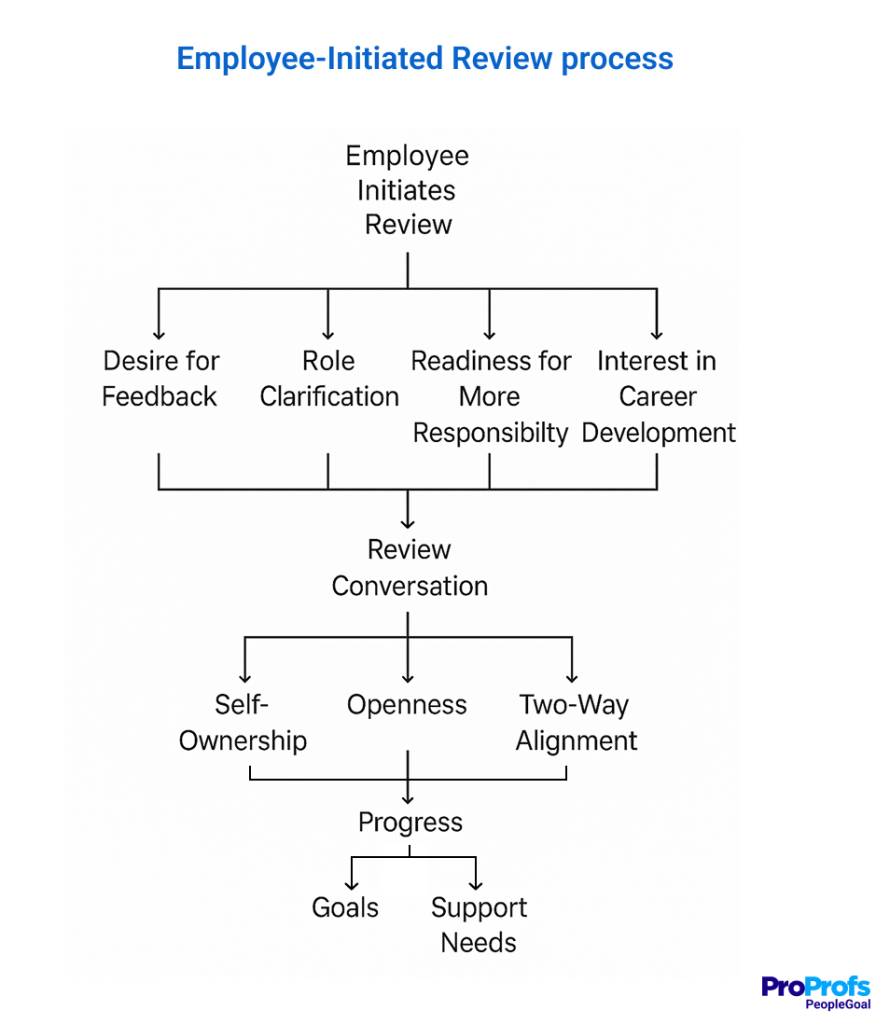
These proactive reviews encourage self-ownership, openness, and two-way alignment on progress, goals, and support needs.
How Employee-Initiated Reviews Are Helpful
- Promotes Proactive Employee Development: Empowers employees to take charge of their growth rather than wait for scheduled reviews.
- Improves Manager-Employee Trust: Shows that the organization values initiative and dialogue, not just top-down evaluation.
- Clarifies Role or Career Uncertainty: Provides space for honest discussion when employees feel stuck, ready for more, or unsure of their next step.
- Helps Uncover Blind Spots: Encourages feedback that might not surface in standard review cycles.
- Supports Engagement & Retention: Employees who feel heard and guided are more likely to stay and thrive.
Performance Review Templates for Employee-Initiated Reviews
1. Employee-Initiated Check-In Request Form
Employee Name: __________________________
Department: _____________________________
Date Requested: _________________________
Preferred Reviewer: ☐ Manager ☐ HR ☐ Skip-Level Leader
Purpose of Request:
Requesting Feedback
Career Development Discussion
Role Clarity or Reassignment
Conflict Resolution
Desire for Promotion
Other: _______________________________
Brief Summary of What You’d Like to Discuss:
Preferred Timeframe for Meeting:
Within 1 Week
This Month
Flexible
2. Career Development Discussion Template
Employee: ___________________________
Manager: ____________________________
Date: _______________________________
1. Current Role Reflection
- What are you enjoying about your current role?
- Where do you feel underutilized or challenged?
2. Career Goals Shared by Employee
- Short-Term (6–12 Months): ____________________________
- Long-Term (2–3 Years): _______________________________
3. Areas to Explore
Leadership opportunities
Cross-functional projects
Skill training or certification
Lateral move
New responsibilities
4. Manager Support Suggestions:
Action Items & Next Steps:
3. Feedback-Seeking Conversation Sheet
Employee Name: __________________________
Date of Review: __________________________
Manager: ________________________________
1. Specific Feedback Areas Requested:
Communication
Technical Work
Project Management
Leadership Readiness
Cross-Team Collaboration
Client/Stakeholder Impact
2. Manager Response Summary
- Strengths noted in requested areas:
- Constructive feedback and suggested growth areas:
3. Joint Action Plan:
Follow-Up Date (if needed): ____________
4. Self-Driven Role Clarity Review
Employee Name: _________________________
Manager: _______________________________
Review Date: ___________________________
1. Areas of Confusion or Overlap in Current Role:
2. Responsibilities or Projects You’d Like to Take On:
3. Any Gaps in Expectations vs. Reality:
Too many tactical tasks
Unclear performance benchmarks
Too little strategic involvement
Other: ___________________________
4. Manager Clarifications & Notes:
Agreed Adjustments:
Role redefinition
New KPIs
Updated title/responsibilities
Additional support provided
5. Growth Advocacy Memo (Employee-to-Manager)
To: [Manager Name]
From: [Employee Name]
Date: [Submission Date]
Subject: Request for Growth Conversation
Hi [Manager Name],
As part of my continued commitment to improving and contributing meaningfully, I’d like to formally initiate a conversation about my development and future with the team. Here’s a summary of my reflection:
- Accomplishments I’m Proud Of:
- Skills I’ve Strengthened:
- Where I’d Like to Grow Next:
- What I’m Seeking:
☐ Stretch assignment
☐ Feedback
☐ Mentorship
☐ Promotion consideration
☐ Learning opportunity
Looking forward to a candid discussion. Thanks for supporting my journey.
Turn Every Review Into a Growth Opportunity
Performance reviews aren’t just formalities—they’re milestones that shape growth, align goals, and strengthen trust across your organization.
Each review type, whether scheduled or situational, has a unique role in nurturing performance and potential. The real magic happens when feedback becomes a consistent, strategic practice, not just an annual event.
You can choose a robust performance review platform like PeopleGoal, which helps you structure, automate, and personalize every review, be it 30-day check-ins or project wrap-ups. With customizable templates, real-time tracking, and built-in collaboration, PeopleGoal takes the admin out of your hands so you can focus on what truly matters: people, progress, and performance that drives results.
Ready to 3x Your Teams' Performance?
Use the best performance management software to align goals, track progress, and boost employee engagement.






